Well, White Dwarves don't explode, so that resolves that. They have insufficient mass.
To do so, the stellar body in question must mass at least the
Chandrasekhar Limit, which is 1.4 Solar masses. Less mass than that, the star will expand to a red giant as it begins to exhaust it's fuel and starts to fuse elements other than Hydrogen. Then, further down the road, it slowly shrinks down to, yes, a White Dwarf, and gradually fades away. This is the future destiny for our own sun. FYI, the Chandrasekhar Limit is actually around eight solar masses, but as the star begins to exhaust it's fuel, it also loses mass (becoming over time a Planetary Nebula), and the core remains below Chandrasekhar. Over that limit, and you get a type Ia Supernovae.
In answer to the other part of your question, were it possible for Proxima to go Supernova, we would all likely be dead - not from "blast effects," per se, but from ionizing radiation and highly energetic particles stripping away the Ozone layer. And we wouldn't get a heck of a lot of notice about it either. A burst of Neutrinos about eight hours prior to the actual optical observations (exactly what occurred with Supernovae 1987a).
Now there
are circumstances in which a White Dwarf
can Supernovae. If it orbits a larger companion, and accretes matter from it, it can be "pushed" over the Chandrasekhar Limit [Edit - forgot to add for Ihwip that this event is known as "Carbon Detonation."]. I'm fairly certain you've seen similar images to the following, which is an artist's representation of a White Dwarf accreting mass from it's parent.
This answer your questions?



